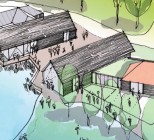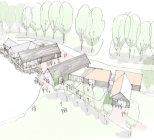South Downs National Park Authority has given planning permission to the Weald & Downland Museum Gateway Project. The project’s main aim is to maintain the Museum’s future viability and the project will transform the way that visitors experience the Museum from the moment they enter the grounds.
“The Gateway Project represents the most important development in terms of the Museum’s long-term sustainability since its foundation,” said Museum Director Richard Pailthorpe. “We now look forward to these plans becoming a reality and creating a better museum for everyone.”
The plans comprise of two clusters of buildings by the Museum’s millpond, providing an enticing vista as people arrive, with a welcoming central courtyard and a layout designed to meet the needs of the Museum’s diverse range of visitors. The southern cluster will include a new ticketing and retail facility, leading through to a series of interpretation galleries. These aim to enhance visitors’ understanding of the Museum and its collection, and the landscape from which its buildings originated. The northern cluster of buildings will house new catering facilities – with views across the millpond and external waterside decking – and a community and learning space, for use as a classroom and for meetings.

A re-configured car park and a new driveway will make much better use of the existing area – including disabled access and coach parking – and create a safer environment for pedestrians through the introduction of a dedicated footpath leading to the new facilities. The project also aims to encourage the use of more sustainable modes of travel by its visitors, including walking, cycling and public transport.
Two of the Museum’s 50 historic buildings, collectively designated by the government for outstanding importance – the Medieval house from Sole Street and the wagon shed from Pallingham Quay, which form the current catering facility – will be dismantled, moved to new sites within the Museum and interpreted for visitors. This work will provide opportunities for trainees and volunteers to be directly involved with conservation work, sharing and developing invaluable heritage skills.
The project will cost £5 million, of which the Heritage Lottery fund will be contributing £4 million. The Museum is in the process of raising the remainder through an active and ongoing fundraising campaign. The project is scheduled to be completed and open to visitors during 2017.










